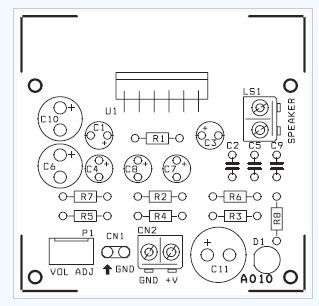
Amplifier Circuits-Audio
Index
Improved 3 Transistor Audio Amp electronic circuit
Published:2013/4/1 3:17:00 Author:Ecco | Keyword: Improved, 3 Transistor , Audio Amp
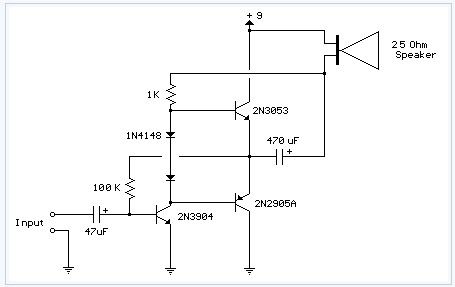
This circuit is similar to the one above but uses positive feedback to get a little more amplitude to the speaker. I copied it from a small 5 transistor radio that uses a 25 ohm speaker. In the circuit above, the load resistor for the driver transistor is tied directly to the + supply. This has a disadvantage in that as the output moves positive, the drop across the 470 ohm resistor decreases which reduces the base current to the top NPN transistor. Thus the output cannot move all the way to the + supply because there wouldn't be any voltage across the 470 resistor and no base current to the NPN transistor. This circuit corrects the problem somewhat and allows a larger voltage swing and probably more output power, but I don't know how much without doing a lot of testing. The output still won't move more than a couple volts using small transistors since the peak current won't be more than 100mA or so into a 25 ohm load. But it's an improvement over the other circuit above. In this circuit, the 1K load resistor is tied to the speaker so that as the output moves negative, the voltage on the 1K resistor is reduced, which aids in turning off the top NPN transistor. When the output moves positive, the charge on the 470uF capacitor aids in turning on the top NPN transistor. The original circuit in the radio used a 300 ohm resistor where the 2 diodes are shown but I changed the resistor to 2 diodes so the amp would operate on lower voltages with less distortion. The transistors shown 2n3053 and 2n2905 are just parts I used for the other circuit above and could be smaller types. Most any small transistors can be used, but they should be capable of 100mA or more current. A 2N3904 or 2N3906 are probably a little small, but would work at low volume. The 2 diodes generate a fairly constant bias voltage as the battery drains and reduces crossover distortion. But you should take care to insure the idle current is around 10 to 20 milliamps with no signal and the output transistors do not get hot under load. The circuit should work with a regular 8 ohm speaker, but the output power may be somewhat less. To optimize the operation, select a resistor where the 100K is shown to set the output voltage at 1/2 the supply voltage (4.5 volts). This resistor might be anything from 50K to 700K depending on the gain of the transistor used where the 3904 is shown.
(View)
View full Circuit Diagram | Comments | Reading(1863)
Ecm Mic Preamplifier electronic circuit
Published:2013/4/1 3:13:00 Author:Ecco | Keyword: Ecm Mic Preamplifier

A microphone amplifier that may be used with either Electret Condenser Microphone (ECM) inserts or dynamic inserts, made with discrete components.
(View)
View full Circuit Diagram | Comments | Reading(1750)
Cheap Audio Booster electronic circuit diagram
Published:2013/4/1 3:08:00 Author:Ecco | Keyword: Cheap Audio Booster
View full Circuit Diagram | Comments | Reading(3507)
3 Transistor Audio Amp electronic circuit diagram
Published:2013/4/1 2:48:00 Author:Ecco | Keyword: 3 Transistor Audio Amp
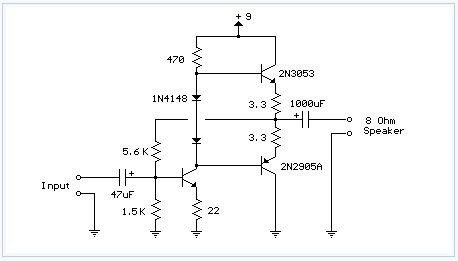
Here is a little audio amplifier similar to what you might find in a small transistor radio. The input stage is biased so that the supply voltage is divided equally across the two complimentary output transistors which are slightly biased in conduction by the diodes between the bases. A 3.3 ohm resistor is used in series with the emitters of the output transistors to stabilize the bias current so it doesn't change much with temperature or with different transistors and diodes. As the bias current increases, the voltage between the emitter and base decreases, thus reducing the conduction. Input impedance is about 500 ohms and voltage gain is about 5 with an 8 ohm speaker attached. The voltage swing on the speaker is about 2 volts without distorting and power output is in the 50 milliwatt range. A higher supply voltage and the addition of heat sinks to the output transistors would provide more power. Circuit draws about 30 milliamps from a 9 volt supply.
(View)
View full Circuit Diagram | Comments | Reading(2085)
3 Channel Spectrum Analyzer electronic circuit diagram
Published:2013/4/1 2:47:00 Author:Ecco | Keyword: 3 Channel Spectrum Analyzer

This 3 channel 15 LED spectrum analyzer is the perfect addition to any audio amp project. It produces fantastic displays on three LED bars that can be individually adjusted for any particular frequency range. The circuit will take line level output from most any audio source, and operates on 12V DC. This means that it can even be run in a car.
(View)
View full Circuit Diagram | Comments | Reading(3646)
25w Mosfet Audio Amplifier electronic circuit
Published:2013/4/1 2:44:00 Author:Ecco | Keyword: 25w, Mosfet Audio Amplifier
View full Circuit Diagram | Comments | Reading(1823)
22 Watt Audio Amplifier electronic circuit diagram
Published:2013/4/1 2:43:00 Author:Ecco | Keyword: 22 Watt Audio Amplifier

The 22 watt amp is easy to build, and very inexpensive. The circuit can be used as a booster in a car audio system, an amp for satellite speakers in a surround sound or home theater system, or as an amp for computer speakers. The circuit is quite compact and uses only about 60 watts.
(View)
View full Circuit Diagram | Comments | Reading(1666)
20w Bridge Audio Amplifier electronic circuit
Published:2013/4/1 2:42:00 Author:Ecco | Keyword: 20w, Bridge Audio Amplifier
View full Circuit Diagram | Comments | Reading(1218)
20w Audio Amplifier Using Lm1875 electronic circuit
Published:2013/4/1 2:41:00 Author:Ecco | Keyword: 20w Audio Amplifier
View full Circuit Diagram | Comments | Reading(1514)
200w Audio Amplifier electronic circuit
Published:2013/4/1 2:39:00 Author:Ecco | Keyword: 200w Audio Amplifier
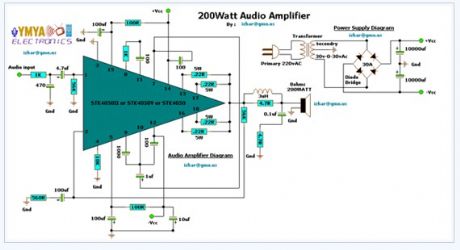
Output Power : 200WattsLoad Resistance : 8ohmsInput impedance : 55KMaximum supply voltage : (+95v)-0-(-95v)Recommended supply voltage : (+66v)-0-(-66v)This complete high quality, low noise mono audio power amplifier is based around the Hybrid Integrated Circuit STK4050 manufactured by Sanyo. The circuit incorporates volume and has a maximum music output power of 200W.The circuit incorporates an on board power supply; therefore, only centre tapped transformer is required to power the circuit. I t has very good quality sound. U can use it with your Home Theatre your PC & etc... You can also use it as Subwoofer Amplifier. It is a compact package for THIN-TYPE Audio sets. Easy Heatsink design to disperse heat generated in THIN-TYPE audio sets. Constant-Current circuit to Reduce supply switch-ON and switch-OFF shock noise. External supply switch-On and switch-OFF shock noise muting, Load short-circuit protection, thermal shutdown and other circuits can be tailored-designed.
(View)
View full Circuit Diagram | Comments | Reading(1684)
18w Audio Amplifier electronic circuit
Published:2013/4/1 2:36:00 Author:Ecco | Keyword: 18w Audio Amplifier

Amplifier parts: P1 = 22K Log.Potentiometer (Dual-gang for stereo)R1 = 1K 1/4W ResistorR2 = 4K7 1/4W ResistorR3 = 100R 1/4W ResistorR4 = 4K7 1/4W ResistorR5 = 82K 1/4W ResistorR6 = 10R 1/2W ResistorR7 = R22 4W Resistor (wirewound)R8 = 1K 1/2W Trimmer Cermet (optional)C1 = 470nF 63V Polyester CapacitorC2,C5 = 100΅F 3V Tantalum bead CapacitorsC3,C4 = 470΅F 25V Electrolytic CapacitorsC6 = 100nF 63V Polyester CapacitorD1 = 1N4148 75V 150mA DiodeIC1 = TLE2141C Low noise,high voltage,high slew-rate Op-ampQ1 = BC182 50V 100mA NPN TransistorQ2 = BC212 50V 100mA PNP TransistorQ3 = TIP42A 60V 6A PNP TransistorQ4 = TIP41A 60V 6A NPN TransistorJ1 RCA audio input socket
(View)
View full Circuit Diagram | Comments | Reading(1527)
10w Audio Amplifier With Bass-boost electronic circuit
Published:2013/4/1 2:35:00 Author:Ecco | Keyword: 10w Audio Amplifier, Bass-boost
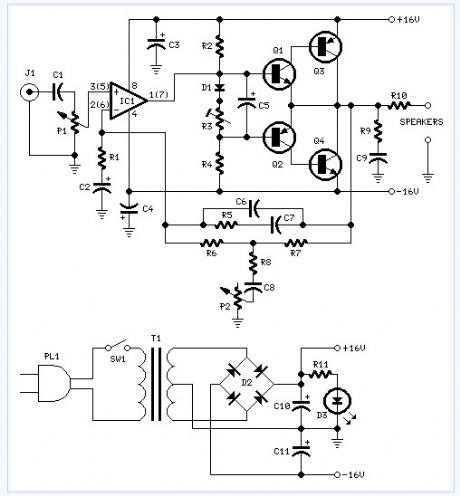
This design is based on the 18 Watt Audio Amplifier, and was developed mainly to satisfy the requests of correspondents unable to locate the TLE2141C chip. It uses the widespread NE5532 Dual IC but, obviously, its power output will be comprised in the 9.5 - 11.5W range, as the supply rails cannot exceed ±18V.As amplifiers of this kind are frequently used to drive small loudspeaker cabinets, the bass frequency range is rather sacrificed. Therefore a bass-boost control was inserted in the feedback loop of the amplifier, in order to overcome this problem without quality losses. The bass lift curve can reach a maximum of +16.4dB @ 50Hz. In any case, even when the bass control is rotated fully counterclockwise, the amplifier frequency response shows a gentle raising curve: +0.8dB @ 400Hz, +4.7dB @ 100Hz and +6dB @ 50Hz (referred to 1KHz).
(View)
View full Circuit Diagram | Comments | Reading(1470)
10w Mini Audio Amplifier electronic circuit
Published:2013/4/1 2:34:00 Author:Ecco | Keyword: 10w, Mini Audio Amplifier
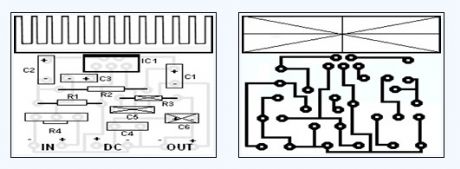
You can use this powerfull amplifier in any small audio project. It is very small (6.5 x 4.5 cm).It outputs 10W and uses a 9V battery.
(View)
View full Circuit Diagram | Comments | Reading(1491)
Audio Power Amplifier circuit for AM Radio
Published:2013/3/29 4:27:00 Author:Ecco | Keyword: Audio Power Amplifier, AM Radio
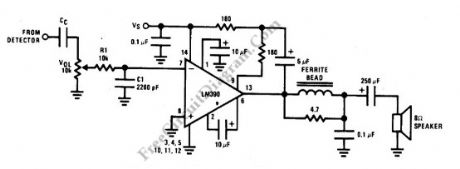
This is an AM radio power amplifier circuit. What is different with other general amplifier is that this circuit has a low-pass filter (passive type), built using R1C1 to limit the input-output frequency response. Additionally, a ferroxcube K5-001-001/3B with 3 turns of wire is used as ferrite bead at output filter. All components should be spaced very close to the IC. The ground and speaker lead must be twisted tightly. The supply lead and supply ground also must be twisted very tightly. Here is the schematic diagram of the circuit:
(View)
View full Circuit Diagram | Comments | Reading(2253)
TDA7056 3W BTL Mono Audio Power Amplifier circuit diagram
Published:2013/3/28 4:02:00 Author:Ecco | Keyword: 3W , BTL, Mono , Audio Power Amplifier
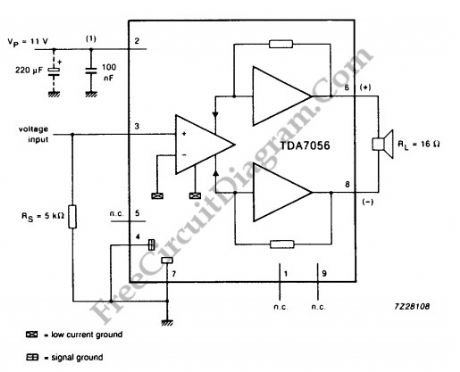
For mono output amplifier application, TDA7056 IC can be your option. Compact but powerful, this integrated circuit is contained in a 9 pin medium power package. This device is designed for battery fed portable equipments such as mono recorders, radios and television. To attract the market, TDA7056 has many features such as low power consumption. For more reliable operation, TDA7056 also has short circuit proof and ESD (Electro Static Discharge) protected on all pins. Designing application with this IC should be easy since no external components is needed. To make sure you’ll love this chip, this device also has no switch on/off clicks. Overall, TDA7056 has good stability.
(View)
View full Circuit Diagram | Comments | Reading(3209)
Small Audio Booster
Published:2013/3/26 3:43:00 Author:Ecco | Keyword: Audio Booster
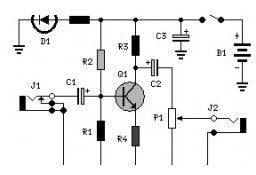
Here the simple, low cost and easy audio booster circuit. It uses a transistor of 2N3392 ad the main amplifier. Component List: R1 = 47K R2 = 470K R3 = 10K R4 = 560R R5 = 270R C1 = 0.1uF/25v C2 = 3.3uF/25v C3 = 470uF/25V P1 = 100K Q1 = 2N3392 D1 = 5mm.
(View)
View full Circuit Diagram | Comments | Reading(1149)
Transistored 10W Audio Amplifier
Published:2013/3/26 3:36:00 Author:Ecco | Keyword: Transistored , 10W, Audio Amplifier
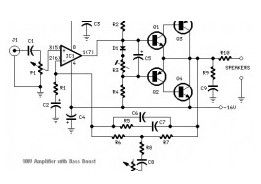
Build based operational amplifier NE5532 and a couple of power transistor TIP41A / TIP42A, this audio amplifier circuit has capability to deliver up to 10W audio power output into 8 ohm speaker.. Amplifier Parts list: P1 22K = Log.Potentiometer P2 = 100K Log.
(View)
View full Circuit Diagram | Comments | Reading(1455)
TDA8929T Class-D Audio Power Amplifier
Published:2013/3/26 3:35:00 Author:Ecco | Keyword: Class-D , Audio Power Amplifier

The following diagram is the circuit diagram of Class-D audio power amplifier which built based on power chip TDA8929T. About TDA8929T: The power IC TDA8929T is the controller of a two-chip set for a high efficiency class-D audio power amplifier system. The system is divided into two chips: TDA8929T; the analog controller chip inside a SO24 package TDA8926J/ST/TH or TDA8927J/ST/TH.
(View)
View full Circuit Diagram | Comments | Reading(1624)
Crystal Radio (and other purpose) Audio Amplifier
Published:2013/3/25 3:25:00 Author:Ecco | Keyword: Crystal Radio , Audio Amplifier
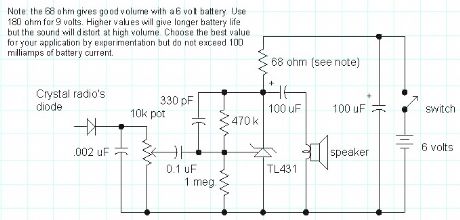
Here is a simple audio amplifier using a TL431 shunt regulator. The amplifier will provide room-filling volume from an ordinary crystal radio outfitted with a long-wire antenna and good ground. The circuitry is similar in complexity to a simple one-transistor radio but the performance is superior (with the exception of the amazing one-transistor reflex ). The TL431 is available in a TO-92 package and it looks like an ordinary transistor so your hobbyist friends will be impressed by the volume you are getting with only one transistor and the amplifier may be used for other projects, too. Higher impedance headphones and speakers may also be used. An earphone from an old telephone will give ear-splitting volume and great sensitivity! The 68 ohm resistor may be increased to several hundred ohms when using high impedance earphones to save battery power.
(View)
View full Circuit Diagram | Comments | Reading(1514)
Op-Amp Audio Amplifier
Published:2013/3/25 3:24:00 Author:Ecco | Keyword: Op-Amp Audio Amplifier

The above circuit is a versatile audio amplifier employing a low cost LM358 op-amp. The differential inputs give the amplifier excellent immunity to common-mode signals which are a common cause of amplifier instability. The dotted ground connection represents the wiring in a typical project illustrating how the ground sensing input can be connected to the ground at the source of the audio instead of at the amplifier where high currents are present. If the source is a power supply referenced signal then one of the amplifier inputs is connected to the positive supply. For example, an NPN common-emitter preamplifier may be added for very high gain and by connecting the differential inputs across the collector resistor instead of from collector to ground, destabilizing feedback via the power supply is greatly reduced.
(View)
View full Circuit Diagram | Comments | Reading(1802)
| Pages:1/13 12345678910111213 |
Circuit Categories
power supply circuit
Amplifier Circuit
Basic Circuit
LED and Light Circuit
Sensor Circuit
Signal Processing
Electrical Equipment Circuit
Control Circuit
Remote Control Circuit
A/D-D/A Converter Circuit
Audio Circuit
Measuring and Test Circuit
Communication Circuit
Computer-Related Circuit
555 Circuit
Automotive Circuit
Repairing Circuit


